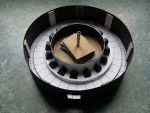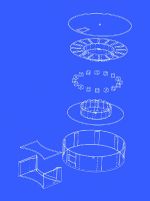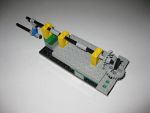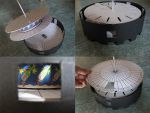Preliminary Considerations
Analog 3D Animation - The Idea
We live in a time where everything is digitally acessable. Photography, cartography, music, films, books and drawings. One by one all major analoge medias are replaced by their digital pendant - and the transformation into "ones" and "zeros" has never been easier. But the technological evolution also offers the possibility to take the opposite direction. With the help of the 3d printer we want to take the step and transform one of the few mere digital medias into an analog counterpart of itself: The analogisation of the digital. The analogisation of mere 3d animation.
3d animation is on of the few movie genres which is almost fully created in digital work. Places and characters are digital. Camera and lighting is digital. And even the carrier medium isnt analog film anymore in many cases. (Pleas note, that we are not referring to Stop-Motion Animation which is actually an analog media.) The possibility to create a movie fully virtual, distinguishes the 3d animation movie from its analog forerunners.
This speciality shall be the starting point of our project. We want to create an alternative draft to the digitalisation of analog medias and analogize a digital media instead. The 3d printer as a distinct media can realize digital operation into analog object. Therefore it is the perfect tool for our aim. Considering this, we are also interested in the abstraction of the printed result, that automatically appears while printing. (Due to the small resolution of the model and the visible plastic layers, created by the printhead)
The Principle of the Zoetrope
To transform digital animation into analog animation there are several ways. The classical way is to expose film material frame by frame with the single shots of the animation until you have a complete copy of the movie. (e.g. for cinema movies) This form of analogisation is not suitable for our aims, cause only the carrier media is analog and real. The animation itself is a virtual image. Besides it is impossible to catch the full range of the 3rd dimension with this method, cause the film image itself is only a two dimensional copy.
Therefore we have decided to use a very old optical technique, which was invented in 1834 by William George Horner: the zoetrope. A zoetrope basically a film sequence, arranged as a 360° panorama, that rotates infront of the viewers eyes. By the use of rotation the animation phases are arranged like a film. But the human eye can see the animation only with the help of a so called shutter. (otherwise the eye is too slow) The shutter in fact, is a kind of image interupter. The enables the slow human eye to perceive the animation through a quick change between image and darkness. (it lowers the framerate of the film by blocking the sight on the rotation with black phases)
Further Information (german)
- Overview on zoetropes
- video showing the functionality of the zoetrope
- overview on praxinoscopes (further development of the zoetrope)
- video showing the functionality of a praxinoscope
Realising the Zoetrope
Based on the principle of the zoetrope we want to realize our 3d animation and enhance the zoetrope technique. In contrast to the original principle, where the shutter slots are on a different level than the animation, we want to imply our shutter in a way that enables viewing the animation not only from above, but also from the front. This also allows us to construct the zoetrope more compact, which will be necessary concerning the size limit of the 3d printer. Additionally the construction shall be self contained, so that the principle of our zoetrope isn't visible at the first sight.
The Shutter
To enable animation and shutter on the same level we have several approaches for realisation. On the one hand we want to try positioning the different animation phases like figures on a carrousel. The shutters shall be constructed like poles between the figures, so that they darken the viewing windows for a short time. This approach probably will not give a good contrast on the animation, because the period of darkness will have to be pretty long to achieve the desired effect.
Another approach is a pure optical shutter. The setting of the animation stays the same as in the other approach. (carrousel) You look on the carrousel through a viewing window from the outside and always see the figure that is nearest to the window. Above the viewing window is a hole for light incidence. This hole will be darkened by a shutter drum between the animation phases, so that a strobe effect is generated. This strobe will divide the animation phases. This effect could also be achieved with a strobe light, but this will probably bring problems with the rotation speed. A mechanical shutter drum has the advance, that the speed of the strobe effect is exactly silmutaneous to the rotation of the carrousel (because the drum and the carrousel are driven by the same crank handle)
Chromadepth
Additionally we want to experiment with a special 3d technique called chromadepth. Chromadepth is a special 3d visualisation that can display colours of a two-dimensional image on different 3d layers. Red colours appear in the front of the image, while blue colours appear in the back. This technique is designed for 2d images. But due to having only a small distance between the viewers eye and our animation this technique could improve the three-dimensionality of our animation.
Expected Problems
For the realisation of our projects we will have to face several issues. Problems that we will have to solve are:
- How does the shutter affect sharpness and contrast of the image?
- Will the relatively low distance between eye and animation be sufficient to create enough spatiality and image sharpness
- How will the 3d printer limitate our possibilities
Practical Realisation
Building the Zoetrope
The Prototype
The first step on our way to realise our analog 3d animation was to build our "display device", the zoetrope. Like the animation we also wanted to create this part of our project in a way, that would allow us to produce it with the 3d printer, so we didn't make any drawings or sketches of the zoetrope. Instead, we decided to "build" the prototype as a 3d model. As we planned to print the zoetrope later on, we had to build it "waterproof" (every printable part had to contain no open planes) and we had to work very accurate to avoid troubles with the printed parts. We also decided to realise an optical shutter automatic (described in 1.3.1. The Shutter), because were hoping for a better animation quality and less use of material. A major advantage of creating a 3d model instead of sketches was the fact, that we could simulate our zoetrope virtually to see, if the technique would actually work. Besides, this approach of creating a zoetrope, was fully virtual. This was a good concession to our aim of analogizing digital work.
When we finished the 3d model we started to simulate the animation in the virtual zoetrope (see videosimulation [[#The Animation in the Zoetrope|]]) The first simulations produced some questions that were only solveable with a real prototype, so we decided to build a functioning zoetrope, mainly made of cardboard.
The 3d printed Zoetrope
After the cardboard prototype was functioning, we started to print parts of it in 3d. Unfortunately we underestimated the time we needed for troubleshooting and the printing procedure itself. After several approaches of printing large parts with ABS material, we switched to PLA and were able to create the first parts of the zoetrope. Due to the huge amount of the time that the printing of large objects needs, we haven't finished the zoetrope yet. (E.g. the cap of the zoetrope needs approx. 8-12hours of printing, depending on the material and settings - and it isn't the biggest part) The parts of the zoetrope that are already printed are: the cap and the LED-Lamp Holder.
<videoflash>taVDJ0AP6cU|400|250</videoflash> Video of showing all parts of the zoetrope's 3d prototype.
The Animation in the Zoetrope
Considerations
After testing the prototype of the zoetrope and the 3d printer we were able to set the basic technical conditions for our animation. So we started to think about the content of our little animation cycle. We came to the agreement that we wanted to animate relatively simple models, because the settings of the zoetrope limited the size of each figure to 1,8 x 1,8 x 1,8cm. With this resolution it would have been very tricky to print detailed models in high quality. And quality would be needed to perceive the fluid animation. Due to a low image sharpness of our zoetrope (low distance between eye and animation, high rotation speed of the carrousel and therefore a slight motion blur) we wanted to focus on 2 forms of movement in our animation, that are well visible despite all technical problems. On the one hand we wanted to focus on the animation of the objects' silhouettes. On the other hand we wanted to experiment with colour morphs. Another limitation that had to be considered was the limited number of frames that were possible on the carrousel. We decided to divide the carrousel into 16 frames, a compromise between number of frames and possible object size.
Based on these technical limitations we decided to do the following animation cycle: <videoflash>9iyOcnh2bZY</videoflash> (3d testanimation)
Symbiosis and Synergie
The animation will be an infinite loop of the 3 Bauhaus basic geometric shapes triangle, circle and square (respectively their three-dimensional pendants pyramid, sphere and cube) with the title "Symbiosis and Synergie". The 3 symbols morph smoothly into each other all within the 16 frames that we have at our disposal. The result is a hypnotic, almost fluid wafting of the forms. In the same it is a quote of the used printing material in its heated form.
We decided to animate the 3 Bauhaus symbols and to use the title "Symbiosis and Synergie", because they symbolize the Bauhaus idea of uniting the big varieties of arts and crafts under one patronage. In a certain way this animation is a self-reflecting document of the 3d printer's principle of operation: Like in the basic idea of the Bauhaus, different crafts have to be connected to achieve a result.
Construction, installation, programming, drafting, modelling, printing are only some fields that play a role. Every single field can exist on its own, but only in a synergetic cooperation the 3d printing is possible.
Therefore it seems to us, that 3d printing and Bauhaus fit together perfectly.
Printing the Animation
We printed the 16 animation frames with white ABS. We split the figures with too much overhang into halfs and glued them together afterwards. Afterwards we went over the models with rasp and sand paper and then used spray paint to dye them black.
The Result
Now that (almost) all parts were done, it was time to combine them to realize our analogized digital 3d animation:(please don't mind the low video quality. Unfortunately we had no better camera.) <videoflash>SUmQLCWrWtM</videoflash>
We hope that we can improve the quality of our construction by replacing the prototype zoetrope by a fully printed zoetrope. All in all we want to state, that 3d printing was a really interesting experience and that we plan to realize other small 3d printing projects in the future. We also plan to improve our 3d zoetrope and to make the .stl data of it public, so that everyone can print their own zoetropes, and hopefully their own 3 animations aswell.
Evolution
4.6.-6.6.
- creation and testing of 2 simple zoetrope models
- the classical zoetrop works, but with a bad contrast
- the 2nd model (a zoetrope with animation and shutter on the same level doesn't work)
(prototype on the right)
- first printings show the boarders of the 3d printer (on the right: test 1 and test 2) you can see that the printer has issues with printing small parts (throat of the chess figure) due to high temperature and printing speed (the printer prints over layers that havent hardened)
- furthermore it appears that strong overhangs arent possible without backings
25.6.-27.6.10
- Creation of a 3d model of the planned zoetrope. The 3d model is alread waterproof and therefore (hopefully) printable.
- Simulation of an animation with the 3d zoetrope. The unusual design of the shutter creates some issues. Due to these troubles a cardboard model of the 3d model is planned to test the shutter in real life:
<videoflash>A1qGF4w98Ho</videoflash> (at a framerate of 256fps the animation becomes bugged and unfluid)
- Construction of a crank handle for the zoetrope (Prototype build with LEGO)
8.7.10
- Building of a working cardboard model with optical shutter, based on the 3d model:
<videoflash>TPzxaY0aD0M</videoflash>
- To improve contrast and image sharpness, further experiments with variations of the shutter size and different light settings are planned
14.7.10
Efforts for optimizing the prototype:
- Decreasing the shutter size for shorter exposure time --> no effect on the animation quality
- Improved isolation of the zoetrope against light from the outside and dyeing the inner parts of the zoetrope to increase contrast --> small improvement of the animation quality
22.7.10
Adjustment of the 3d model due to experiences with the prototype:
- the height of the inner drum is decreased. therefore the drum has more space for rotation
- adjustment of the center line
- the blinds are removed due to inefficiency
- reduction of the wall sizes (=reduction of material needed for printing)
27.7.10
- Brainstorming ideas for animation content
4.8.-6.8.10
- creation of the final animation for the zoetrope
(Video hier)
9.8.10
- experimenting with animated colourmorphs
<videoflash>n1ImjejuEa0</videoflash>
18.8.10
- setting up skeinforge and bfb axon on 2 laptops and testing the program settings
- installing additional printing profiles
- adjusting 3d file and bugfixing
25.8-26.8.10
- first printing test, for results see Printer queue
30.8.-2.9.10
- printing of the complete animation cycle, results are viewable at Printer queue
15.8.-16.9.10
- 1st printing test of the cap of the zoetrope. Results here
21.9.10
- 2nd printing test of the zoetrope cap. Results here
22.9.10
- installing the crank handle on the cardboard prototype of the zoetrope
- minor repairs on our models with glue, rasp and sandpaper
25.9.10
- dyeing the animation cycle with black spray paint for better contrast in the zoetrope and softer surface
- further optimization of the cardboard prototype of the zoetrope
27.9.10
- further optimization of the cardboard prototype of the zoetrope
28.9.10
- printing the cap of the zoetrope and the LED-Lamp Holder Results here
- installing the animation cycle into the prototype
29.9.10
- applying the LED-Lamp Holder
- finishing the installation of the zoetrope prototype
30.9.10
- creating an animation of the 3d model of the zoetrope (hier)
- failed attempt of printing a part of the crank handle gear
13.10.10
- part of the crank handle gear successfully printed. Results here
25.10.-26.10.
- new version of the zoetrope's 3d model (viewing windows is bigger and in a higher position for better 3d perspective on the animation, shutters on the shutter automatic are bigger to let in more light, for a better contrast)
- several hours of printer troubleshooting, failed attempt of printing 2 more gear parts
9.11.10
- new parts of the crank handle were built. See results here
8.12.10
- presentation of the prototype in the seminar "Remedialisierung – postfotografische Modi des Filmbildes"
Feedback
Glückwunsch! Ihr habt den ersten Wiki-Eintrag des Kurses verfasst! Sieht schon mal gut aus. Fehlt nur noch Bild und Kurzbeschreibung auf der Kursseite.
Das Praxinoskop ist ja auch ein interessantes Gerät. Und ich bin auf euer Kompakt-Zoetrop gespannt. Euer Ansatz hat einiges an Potential, ich bin sehr gespannt, wie ihr das entwickelt.
Mehr Bilder wären gut, bei euch bieten sich ja auch laufende Bilder sehr an :)
Videos ins Wiki einbetten geht: So!
Videos und Skizzen sind in Arbeit und kommen dann demnächst.
- Ist 3D Animation wirklich etwas rein digitales? Was ist mit 'Wallace & Gromit', um ein Beispiel zu nennen?
Die 3D Animation von der wir reden ist nur digital möglich. Über Filme wie Wallace und Gromit und ähnliche, haben wir auch schon nachgedacht. Allerdings zählen die nicht zu 3D Animation, sondern eher zu Stop-Motion, sind also auch mit rein analogen Techniken umsetzbar.
- Warum Cromadepth für euer Vorhaben besonders geeignet ist? Wofür braucht man einen 3D Effekt, wenn man ohnehin schon dreidimensionale Objekte hat?
Ob man Chromadepth wirklich braucht, wird sich zeigen. Vermutlich geht es auch ohne. Aber wir hoffen, dass es schlicht und ergreifend noch besser aussieht :)
- Könnt ihr den Abstand zu den Augen nicht einfach festlegen?
Das wird sich auch im Test ergeben. Vermutlich wird eine Art Aufsatz den Abstand des Betrachters vom Zoetrop regeln
- Und: Was für eine Animation wollt ihr eigentlich zeigen?
Sehr gute Frage, darüber machen wir uns Gedanken, wenn die Technik funktioniert. --sebastian 17:00, 16 June 2010














